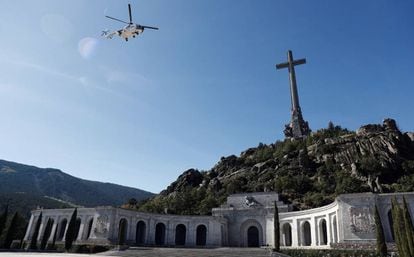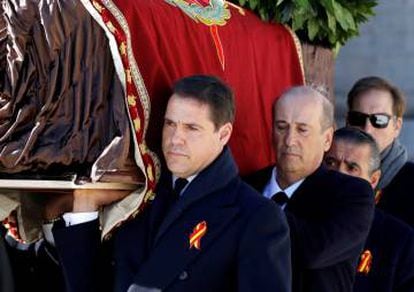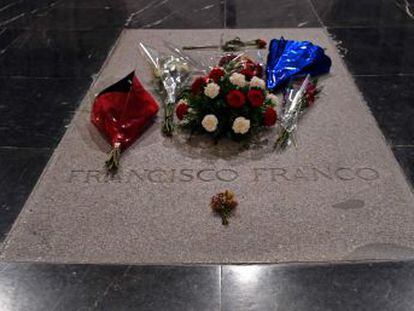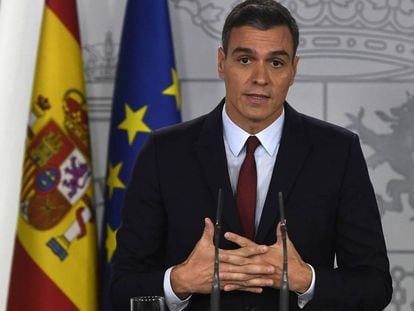Valley of the Fallen faces uncertain future after Franco’s exhumation
While the caretaker government wants to turn it into a place of memory and reconciliation, long-term plans are on hold until after the national election of November 10


Franco’s exhumation on Thursday was the first step toward changing the meaning of a monument that was imagined by the late dictator as a way to immortalize his own victory in Spain’s Civil War (1936-1939).
But the future of the Valley of the Fallen has yet to be defined, and it will depend to a great extent on the outcome of the general election that will be held on November 10.
The caretaker prime minister, Pedro Sánchez of the Socialist Party (PSOE), noted on Thursday that the remains of nearly 34,000 victims of the war are still lying at the Valley, in most cases buried there without their families’ consent.
“This is an infamy that must be redressed sooner or later,” he said. “When it reopens, the Valley of the Fallen will mean something very different: it will be a memorial to a pain that must never happen again, and a tribute to all the victims of hate.”

Removing Franco’s remains “is a necessary condition, but not a sufficient one, to re-purpose the Valley of the Fallen,” says Ramón Jáuregui, a former PSOE minister who eight years ago watched as an incoming conservative government led by the Popular Party (PP) took an experts’ report on the Valley and tossed it in a drawer, never to look at it again.
That report, drafted by experts in law, history, philosophy and anthropology, had been commissioned by the previous PSOE administration of José Luis Rodríguez Zapatero, and its conclusions included the recommendation that Franco’s body be removed from the Valley.
Authorities now face the daunting task of turning the Valley of the Fallen into a place of memory and reconciliation. These are some of the issues that they will have to take into account:

1. The role of the Benedictines
The site is run by the Foundation of the Holy Cross of the Valley of the Fallen, which was created in 1957 under Franco. A community of Benedictine monks is in charge of it, and receives an annual state subsidy of €340,000 to carry out its duties. The government is now considering placing the foundation under direct orders from the executive, or else reaching a new agreement with the Catholic Church to replace the Benedictine community with another Church institution.
“The Benedictines have earned an expulsion from the Valley. Their hostility to the transformation of the monument is incompatible with their presence there,” says Jáuregui. “They had a mission, which has to protect Franco’s grave, and that mission has ended.”
2. The grave of Primo de Rivera
The government also wants to move the grave of José Antonio Primo de Rivera, founder of Spain’s fascist-inspired Falange party, from its current spot near the altar of the basilica to one of the sides. In 2011, the expert report agreed that Primo de Rivera could be considered a victim too, as he was executed by the Republican government in November 1936, during the first months of the war. Not everyone agrees with this view.
3. The biggest mass grave in Spain
In 1940, a year after his victory, Franco had no intention of including the enemy’s dead in his project for the Valley of the Fallen, which he thought would be completed in six years. Instead it took 18. In many cases, the Franco regime opened up mass graves and took the bodies of thousands of republicans to the Valley without their relatives’ knowledge or consent. The government now wants to return those remains to their relatives and repair the Valley’s columbaria, which have been damaged by damp.
4. Interpretation center
There is still no decision on how the Valley of the Fallen will become a “place of memory,” and everything is on hold until after the election. Jáuregui would like to hold “an international competition for ideas” to turn the esplanade in front of the basilica into an interpretation center. Francisco Ferrándiz, an anthropologist at the state-run scientific council CSIC, is asking for “a brave an ambitious project,” and notes that it took “15 years of social and political debate” to complete the monument to the victims of the Holocaust in Berlin.
English version by Susana Urra.













































